Table of Contents
**This page contains affiliate links and I will be compensated if you make a purchase after clicking on my links**
In an ideal world, you’d live in a mini-mansion with lots of extra bedrooms for guests. But most of us live in a small space where home design has become a giant game of Tetris.
Every room, and every square inch in that room, needs to accommodate multiple functions.
Your “office”, the “game room”, and even the “family room” may need to double as a guest room.
Even if you don’t have a mother-in-law that drops in unexpectedly, it always good to have a guest “space” available.
You may need to separate a family member due to obnoxious snoring.
Or, you may need to separate a family member due to potential illness.
The best alternative is a simple sofa bed. Sofa by day, and with minimal effort, a complete-sized bed for sleep.
- Pet safety alert: cats and small dogs like to hide under extended sofa beds. When converting it back to a sofa, first check underneath.
But, as you are aware, that mattress needs to scrunch up to fit into the sofa. Most sofa beds come with a thin inexpensive uncomfortable thing that barely qualifies as a “mattress”.
Let’s upgrade that sofa bed to be more comfortable.
1) New sleeper sofa mattress
When you purchase your sofa bed, you may be given the option to upgrade your mattress.
DO IT.
If not, you can purchase a mattress separately. However, as this mattress is designed to fold up flat in a sofa, your choices are limited.
Air mattress for sofa bed
Fortunately, I upgraded when I purchased my sleeper sofa. Mine folds out into a Queen-sized mattress. This mattress is an air mattress covering a layer of compressible metal coils. A plug-in pump is provided that will fill the mattress in less than a minute.
This mattress made by Air Dream (not affiliated) is not cheap. However, all my guests have been very happy with the mattress. And I’ve had no issues.
On the downside, this is an air mattress, and prone to the usual problems, such as leaking valves. As a result, some internet reviews have been mixed, but overall positive.
Memory foam mattress for sofa bed
The (less expensive) alternative is to find a foam mattress designed for a sofa bed. These mattresses may be made of latex or other foam that easily compresses when folded up.
Memory foam is the preferred material. This “viscoelastic” foam made of polyurethane uses your body heat to soften and support your body. This foam springs back to its original form when not in use.
Earlier versions of memory foam were famously hot to sleep on. Newer formulations have introduced gel and a more open cell structure to aid breathability and cooling.
(Although personally, I still find them too hot…)
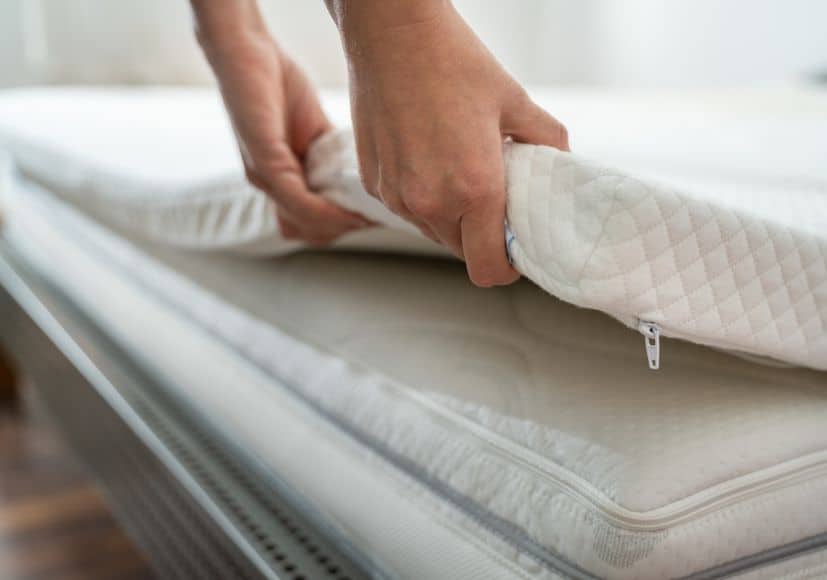
2) Foam mattress topper
A compromise is to keep the current sleeper sofa “mattress” and add a foam topper. These come in several types of foam, including memory foam.
Various thicknesses are also available, the thicker the better.
Again, when choosing a memory foam topper, look for one with an open cell structure and cooling gel.
As toppers are designed for conventional beds, there is a much wider selection. Ideally, it should compress enough so that you won’t need to remove it when putting your sofa back together.
However, keep in mind that thicker mattress toppers may need to be stored separately, when not in use.
Mattress toppers may also come with an optional cover. These covers can be wrestled off and washed as needed. The cover should be made of a breathable material such as cotton or bamboo.
3) Down alternative mattress topper
Instead of foam, there are quilted mattress toppers available, stuffed with “down alternative”, a 100% polyester fill.
These may not provide as much support as the foam, but the big advantage is that the whole thing can be thrown in your washing machine.
(Note, depending on the size, it may not actually fit in your washing machine.)
Mattress toppers may sit directly on your current mattress or they may have corner straps to keep them in place
And obviously you can combine one of these toppers with a foam topper underneath.
4) Mattress pad
Assuming the mattress, plus optional topper(s), is soft and supportive enough, the next layer should be a mattress pad.
Mattress pads usually have a quilted top with a thin layer of polyester fill. This fill is much thinner than that found in a “topper”.
Mattress pads also have sides made of stretchy material to secure it to the mattress. Your sofa bed mattress, even with a topper, is much thinner than a conventional mattress, so the fit will be loose. That’s fine.
If the continence of your guest is in question (eg, young children or the elderly) consider a mattress pad with a layer of waterproof polyurethane (PU). Unlike vinyl (or worse, rubber or plastic), PU doesn’t crinkle, and it breathes. Your guest won’t know it’s there…
Unlike the foam topper, which you’re probably trying to store inside the sofa, the mattress pad should be switched out and laundered after each guest. Just like you plan to do with the sheets and the rest of the bedding, right?
5) Sheets and other bedding
When you purchased your sofa bed, hopefully, you went with a size like other beds in your household. For example, if you sleep on a queen-sized mattress then go with a queen-sized sofa bed.
This way you can use “your” extra sheets for your guests as well. So, if you like sleeping on high-quality Supima cotton, then your guests can as well.
(There are MUCH BETTER fabrics to sleep on… but that is topic for a separate post.)
Ideally, provide only washable—and recently washed—comforters and blankets. Don’t forget to leave an extra blanket or two in the room in case it’s needed.
If your sheets are coming out of storage, they may be a bit stale. Throw them in the washer on rinse-only, then dry. Remove promptly.
If just wrinkles are an issue, you can spritz them with water from a spray bottle. Flatten the wrinkles with your hands and let dry. Note, this works best with fast-drying fabrics… but not so much with cotton.
For cotton, you may need to send them to the dryer. Or utilize your steamer.
(The hardcore will pull out their iron and ironing board, but for most of us that’s too much effort…)
6) Pillow variety
There is no such thing as too many pillows when it comes to your guests. Everyone has a preference, so provide lots of pillows, all with different feels. Thin, thick, dense, loose, polyester, memory foam, the works.
Avoid down or feathers, unless you know your guest is NOT allergic.
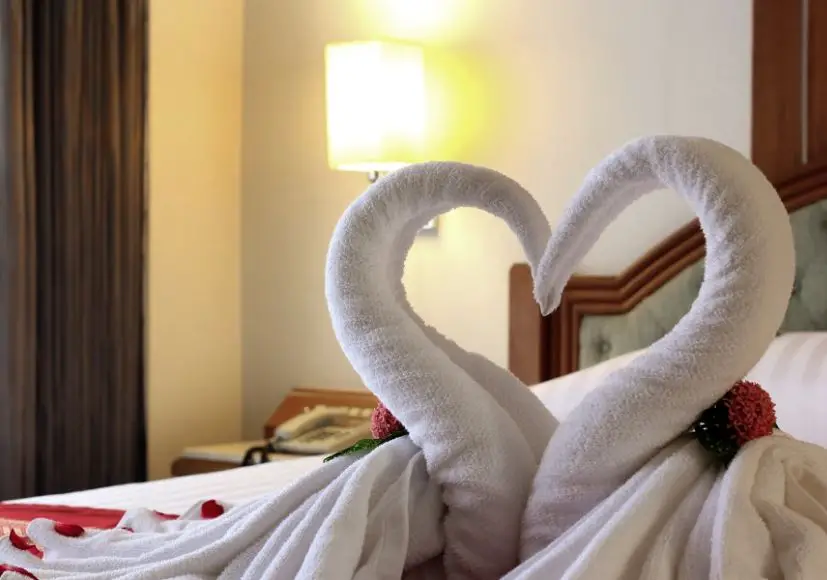
7) Bonus I: double-down on the Hotel look
For extra credit, give your guests the sense that they are staying in a premium hotel.
Use light-colored bedding
Hotels use white bedding exclusively because it looks clean. There’s no way to hide stains or grime.
Remember, we all may be very comfortable with our OWN filth. But when it comes to other people’s filth, we get very squeamish… And your guest may not be privy to your hygiene habits and standards.
White bedding is hard to keep white, so acceptable stand-ins include shades of cream and light grey. The lighter the color and cleaner-looking, the better.
Triple-sheet the bed
Your blankets and comforters may not be light-colored. No problem, use a technique used by hotels, called triple-sheeting.
Place your fitted and flat sheet as usual. Layer on a blanket or comforter. At the very top layer on the third sheet. This (close to white) sheet acts as a bedspread. It can also substitute for a duvet cover.
For an extra-neat look use hotel corners (formerly called “hospital corners”).
You don’t need to iron this third sheet. You can spritz is with water and smooth out the wrinkles with your hand. As above, if wrinkles are more serious, first dampen it and dry it in the dryer. Or pull out a steamer.
Add a throw to the end of the bed
Include a colorful throw-blanket at the end of the bed. If your guest becomes chilly, they can grab this quickly.
Keep the décor minimal
This may not be possible in your overcrowded Tetris home where every available space is utilized.
But if you can, keep the décor minimal: a nightstand, a dresser, a mirror, lights, and a few pictures on the wall. Full stop.
Your guest may have issues falling asleep with a crowd of dolls, action figures, stuffed animals… or clowns staring at them…
There is, however, an exception for bookshelves of books. If your guest suffers a bout of insomnia, some reading material may be appreciated.
Provide extra toiletries
If you travel a lot, you probably have a gazillion tiny bottles of shampoo and hand lotion. And tiny soaps.
If you’ve been to the dentist regularly you also have a gazillion toothbrushes, small tubes of toothpaste, plus dental floss. If you shop for makeup you’ve collected samples of face cream and perfume.
Leave some in an attractive basket in your guest bath or bedroom.
(And donate the rest.)
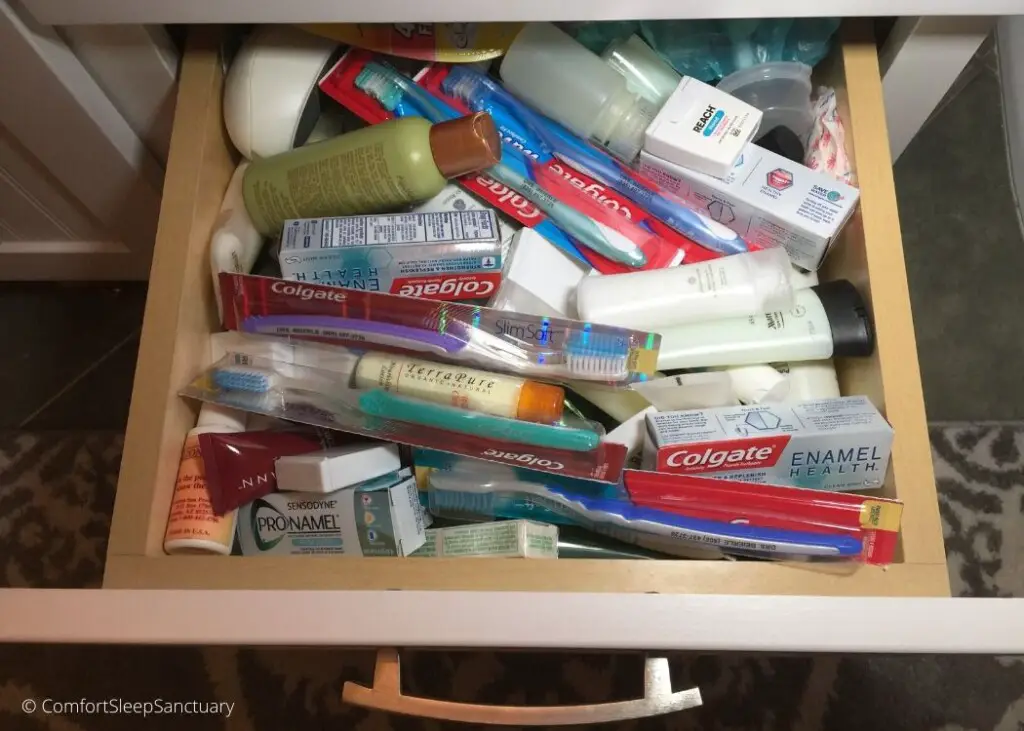
Suitcase stand
Most guests are used to dumping their suitcase (backpack, duffle bag) on the floor. For extra credit (and if floor space allows) provide a suitcase stand.
A low table will also work. Just let your guests know what furniture it’s ok to chuck their stuff on.
Clothes steamer
Yes, a real hotel would provide an ironing board and an iron, but we concede that you most likely don’t own either of these items. (I certainly don’t.)
A portable steamer left on the dresser or in the bathroom is a nice perk.
8) Bonus II: other niceties for your guest
Now that you’ve upgraded the sleeper sofa, what other niceties can you add to ensure that your guest has a good night’s rest?
Temperature control
There’s nothing worse than being the wrong temperature. Too hot or too cold and you won’t be able to sleep.
Everyone has their preferred sleeping temperature, and yours may be very different than that of your guests.
According to sleep experts, our bedroom should be between 60-67 ºF. We create a warmer microclimate under the covers, exposing a foot, leg, or arm, to the outside when we get too warm.
If it’s winter, make sure your guest has access to extra blankets. And perhaps even a space heater.
If it’s summer, include a fan in their room. If your location cools down at night, show your guest how to open the window for an additional cool breeze.
At present, there is an ongoing dispute between those who prefer the air conditioning to run at night and those that don’t. If you fall into the latter camp, but your home is still warm, consider making the sacrifice for your guest and turn on the AC.
(Personally, I prefer a whole house fan at night, which cools without resorting to AC use.)
Humidity control
The perfect humidity is around 50%, with the general consensus that we are most comfortable in the 40-60% range.
Your guest probably won’t notice if the humidity is slightly off. However, if you live in a very dry or very humid location, and your guest is from out of town, they may prefer the presence of a humidifier or dehumidifier, respectively.
A small, inexpensive model should cover their small sleeping space adequately.
Lighting
Like a blind person, you may have taught yourself to navigate your home completely in the dark. Or at a minimum, you can locate the light switches by feel.
However, your guest doesn’t have this spatial knowledge.
- Include a night light in their designated bathroom
- Plus, a night light for the hallway leading to that bathroom
- Include a reading light by their bed that they can turn on and off from the bed
A bedside light will prevent your guest from stumbling in the dark to find the light switch by the door. As a bonus, they can use it to peruse the library of reading material that you may have left them.
Don’t forget that all these lights should be shifted towards the yellow, orange, or amber end of the spectrum. Blue light inhibits sleep.
Darkness
Some of us prefer to sleep in complete darkness, while others—like myself—find that claustrophobic and prefer a little light.
For safety, this guest space must have some type of “egress”, usually a window.
Consider your curtains.
- Install “blackout” curtains
These curtains have an extra layer or two of fabric to completely block the light. These curtains are ideal for late sleepers and those on shift schedules.
- Optional: install a second set of “sheer” curtains
These will provide some privacy while allowing light to enter.
And no, you don’t need two curtain rods. On a single curtain rod install the blackout curtains on the outside, and the sheers on the inside. Adjust as needed.
- Provide your guest with an eye mask
(I have several of these after purchasing affiliated products for review…)
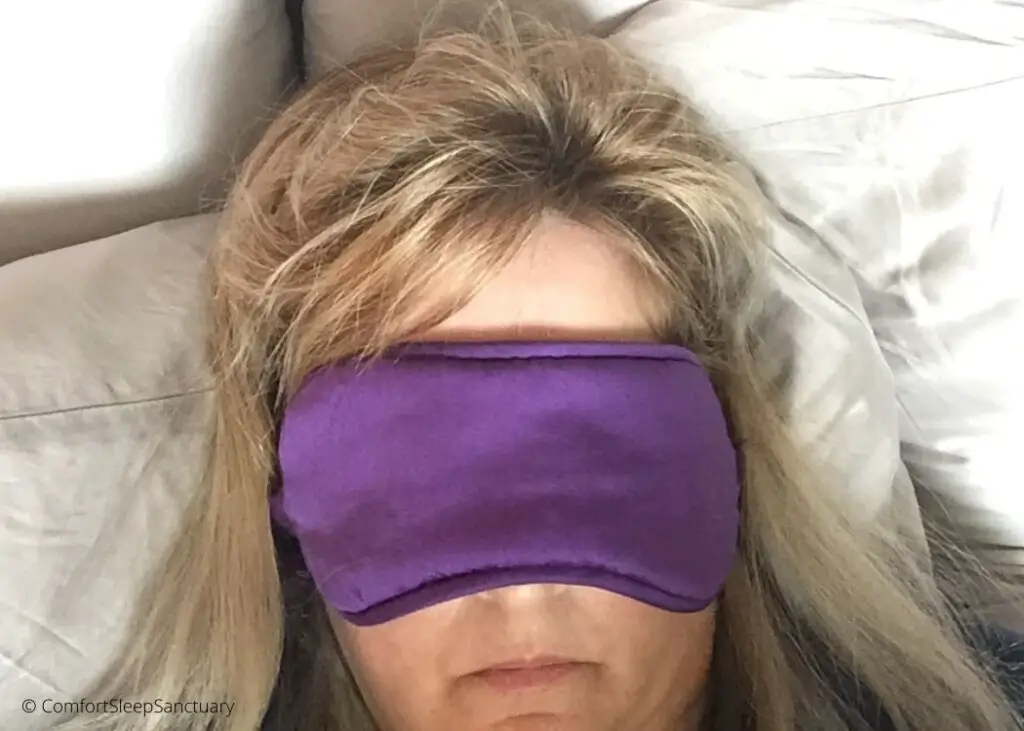
Power for devices
At a minimum, your guest has a phone, but most likely a few more devices that must be kept charged.
Have an easily accessible outlet. A power strip is preferred.
- Also include a charger and cords for multiple types of phones, both iPhone and Android
Often a guest will forget to pack their charger…
Your WiFi password
This is NOT optional.
This applies to any guest, not just overnight guests. Cell phone coverage for certain carriers may be non-existent in your home.
Your guests shouldn’t spend extra for cellular bandwidth. Or worse, be completely cut-off.
These days internet access is as critical as electricity or running water.
Leave a large post-it on your refrigerator advertising your password. There are even special refrigerator magnets available.
You can also post a discreet sign in the room where guests are most likely to congregate.
Space for their stuff
As mentioned above, the guest space should be as minimal as possible. Your guest needs room to spread out their stuff.
- Space for their suitcase
- Space on the dresser for their small items
- Space in the dresser if they’re staying awhile
- Space in the closet to hang clothes. Plus a few empty hangers
Extra blankets and towels
You might think one towel is enough after a shower. But your guest may prefer three.
Provide your guests with extra towels. Better yet, show them your stash in the linen closet and encourage them to help themselves.
Water bottle(s) on the nightstand
We all need to stay hydrated. Save your guest a (bumbling) trip to the bathroom or kitchen.
Kleenex on the nightstand
If your guest has traveled, they may have picked up a mild cold. If they are prone to allergies, they will have no tolerance for your brand of home allergens.
(For more on allergies, scroll below.)
Even more toiletries
Keep extras of these in their designated bathroom and let them know they are free to use if needed.
- Mouthwash
- Band-aids
- Sample sizes of antiperspirant
- Sample sizes of Chapstick
- Common over the counter (OTC) medications, such as acetaminophen (Tylenol®)
- If you have pets or it’s hay fever season, include OTC allergy medications
- If your cooking is questionable, include OTC diarrhea medications, such as Loperamide (Imodium®)
- Feminine hygiene products
- Wipes
- Hairdryer
If their designated bathroom includes a bathtub, also include bath salts and other additives. (Remember, that a warm bath or shower before bed can help you fall asleep.)
This should be obvious: extra toilet paper rolls. (Or whatever paper or cloth product we’re using as a substitute in this post-apocalyptic world.)

Even more on the nightstand
Anything else? Here’s a few more things to include
- Mirror
- Lint brush. (Mandatory if you have pets.)
- Magazines. (Also good for reading in the bathroom…)
- Remote for the TV (if present)
- Clock radio
This last one is only for your older guests who may or may not own a smart phone.
Protect your guests from allergens
This is not so much an upgrade, but a requirement of a good host. Be cognizant of any medical or disability accommodations your guest may need.
Does your elderly guest need to use the bathroom with the walk-in shower, or need a place to sit while showering?
I have allergies, so here are some additional steps for your guests with allergies.
Vacuum thoroughly
Vacuum everything. Before your guest arrives, open the sofa bed and use a hand vacuum to clean all the nooks and crannies. You may find a surprising amount of cracker crumbs…
This should be obvious, but vacuum and clean the room, including any dust that has accumulated on shelves.
(If possible) ban pets from the guestroom
This only works if you have a standalone guest room, but if possible, permanently ban pets from entering this room.
(Easier said than done…)
Use a mattress pad or cover
Other than vacuuming, there isn’t much you can do about the mattress itself. Add a mattress pad to create another layer between the mattress and the sheets.
Use freshly laundered bedding
Not just sheets, but blankets, comforters, and yes, even pillows, should be freshly laundered.
With use, these items will collect dust mites. These microscopic creatures feed off our dead skin flakes and are mostly harmless. But many of us are allergic to their droppings.
Dust mites and other allergens can easily be removed from bedding. Wash on HOT (> 130 ºF) with conventional laundry detergent.
Avoid down and feather bedding
Many are allergic to down and feathers. Instead, use “down alternative” which is simply 100% polyester.
Avoid real flowers and other scents
Fresh flowers might seem like a nice idea, but some people are sensitive to strong scents. Likewise, skip the diffuser.
Instead, consider a few silk flowers. (Don’t forget to dust them.) Or bottles of room spray for your guest to use. Or not.
And no scented candles. You don’t want your guest to burn down your home. (Candles are allowed in the bathroom, however.)
Other space-saving guest beds
Back to sofa beds (also called sleeper sofas). Although the sofa bed is a convenient way to hide a guest bed in a family space or den, there are other options.
Murphy bed
If you have the wall space and the cash, consider a Murphy Bed. These beds flip up into or against the wall when not in use.
These beds may be built in. When up, they are flush with the wall, leaving the maximum amount of floor space free for other uses.
Alternatively, you may purchase (or have built) a standalone version, which may stick out from the wall like that of your average large shelving unit.
Indeed, it may even have shelves on the “underside”. These shelves are of limited use, as anything on them will need to be moved prior to pulling down the bed.
Tables, chairs, and other furniture you place in front should be lightweight and easily moved when you need to transform your room.

Futon
Most of us went through a phase in early adulthood where we slept on these inexpensive futon beds. A simple wooden frame transforms easily from an upright sofa to a flat bed.
Traditionally, futon mattresses are made of 100% cotton, including the stuffing. These tend to be significantly firmer than a traditional mattress. Fine for back sleepers. And young people.
For a better-quality futon, look for wool stuffing.
Nowadays, “futon” mattresses may be found that are like conventional mattresses, including coils and/or a layer of memory foam.
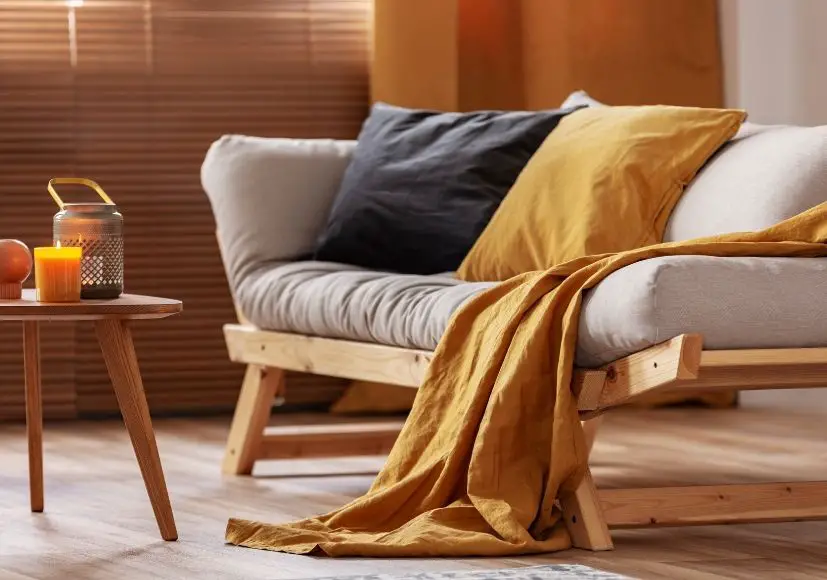
Note, that the wooden frame is only needed if you want a sofa. An alternative is to simply use the mattress on the floor and roll it up when not in use. For this plan, you’ll require a slightly thinner futon that is designed to roll up. (Eg, no coils…)
This might be a great option for when your children have sleepovers.
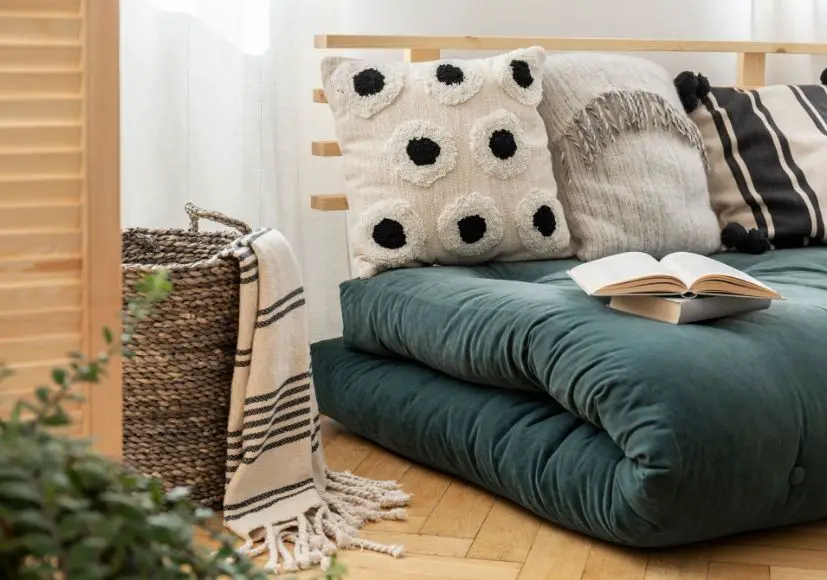
There are other foldout furniture options composed of squares of covered foam. Once extended, you have a mattress-sized area to sleep on. Folded up, the squares create a chair- or couch-like configuration to sit and lean against.
This type of furniture is inexpensive, but no one will mistake it for a conventional sofa or couch. For the casual room only.
Daybed
A daybed is a twin-sized bed with an unconventional frame. This frame has a “back” along the long end, as well as raised “sides” at the head and the foot.
To make it look more like a couch, you’ll need an attractive blanket, bedspread, or throw. Plus, a ton of throw pillows to lean against.
You can skip the unconventional frame and simply shove your twin-sized bed up against a wall and add pillows.
Unlike a sofa bed, that comes in many sizes, including queen and king, the daybed will only accommodate one person.
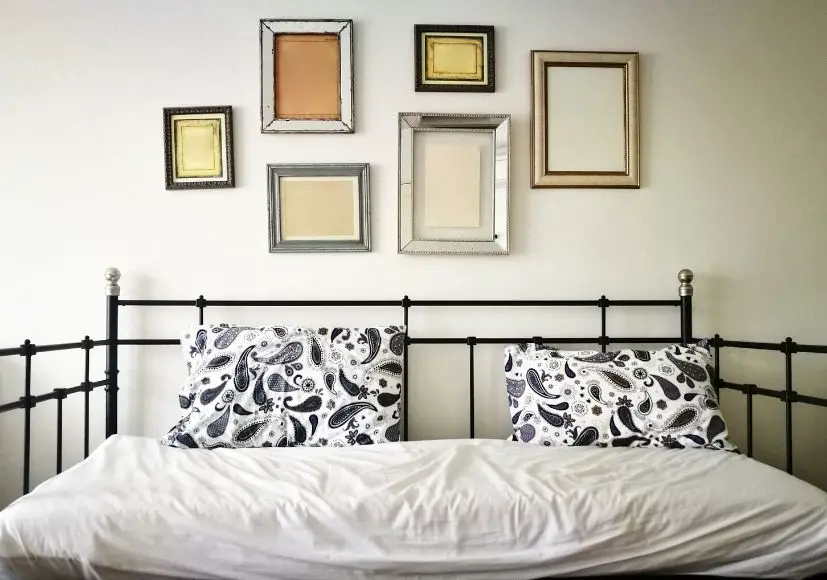
Folding cot
There is the simple folding cot made of canvas and used for camping. Fancier versions have a twin mattress that folds in half, sandwiched by a metal frame. Both versions can be stored in a closet when not in use.
Inflatable mattress
Inflatable mattresses have come a long way from the old days of camping mattresses that you needed to inflate by blowing into them.
Newer models have an onboard pump. Simply plug them in, flip the switch, and less than a minute later you have a fully inflated mattress.
Likewise, they come in all sizes, such as twin, queen, and king. Fully inflated, they are the size and height of a conventional mattress.
For a picky sleeper, like myself, they are quite comfortable. Indeed, they may be cooler than a conventional mattress during hot weather. (This is the one I purchased.)
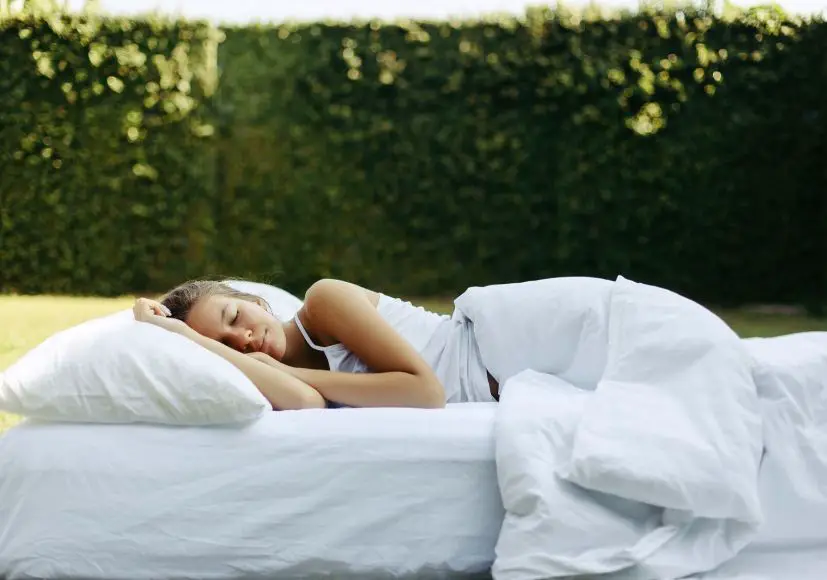
You can even have an inflatable “bed”. These air mattresses are as tall as a regular bed and even have a “headboard”.
There you have it. Yes, it’s possible to make your guest more than comfortable while sleeping on an unconventional bed in an unconventional home space.
Nightie night.
Top photo © Kirill Kedrinski via Canva.com
Want to learn more about the products mentioned?
[If you experience issues with menus or links not working, it is most likely due to your Ad blocker.]



